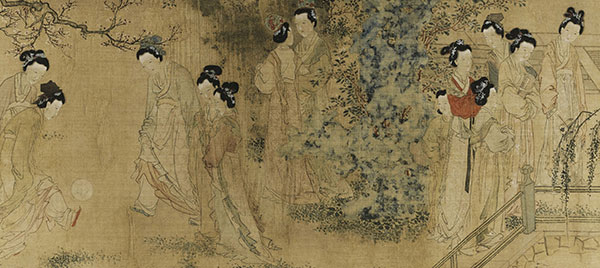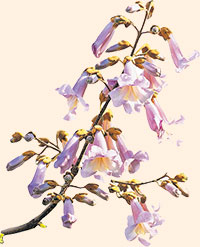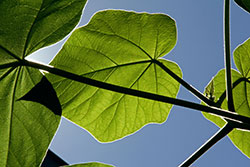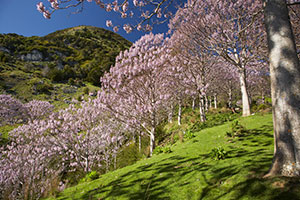500-year-old Chinese painting hints at football’s female origins

Simply sign up to the Life & Arts myFT Digest -- delivered directly to your inbox.
So many of our best winter-flowering shrubs came to the UK from China. I have been following their route in reverse, thanks to the recent exhibition on Chinese painting at the Victoria and Albert Museum in London. This remarkable show was so popular that it became difficult to see its long scrolls under glass among the queues of so many keen spectators. On my visit, I noted the paintings which related to gardens and flowers and vowed to study them more closely with the help of the expert catalogue. The show has now ended but the catalogue, edited by Hongxing Zhang, lives on in bookshops and is an essential addition to keen gardeners’ libraries. It has increased my initial pleasure.
Which will surprise readers of the Weekend FT more, the discovery that Chinese court ladies played football in the garden in the 15th century, or the discovery that a Mr Tang was painted in that same era, reclining in a rattan garden chair beneath a tree and having a “pure dream”?
I hope the ladies are more unexpected. Mr Tang is not our respected David, House & Home’s agony uncle, taking a nap. He is Tang Yin who ranked as the top scholar in his province’s exams but came to grief when he sat the national exams in Beijing. He was alleged to have given a bung to the senior examiner’s assistant in order to see the papers in advance. There was nothing left for him but to become a Buddhist, paint and write poetry. He is shown in his chair beneath the branches of a Paulownia tree, his eyes closed. “The Paulownia shadows cover the purple moss”, the accompanying poem by Tang says. “The gentleman is at leisure, feeling an intoxicated sleep, For this lifetime, he has already renounced thoughts of rank and fame, The pure sleep should not have dreams of grandeur.” There is no sign that he has taken to advising correspondents on manners and etiquette. In my garden I have two Paulownias, hanging on to life despite the cold winter of 2013. In warmer counties like Hampshire these quick-growing trees sometimes even flower. Perhaps we should set a deckchair beneath them and snooze, remembering VAT inspections of the past.

The footballing ladies are truly surprising. One of them has a dainty foot extended and a big round ball in the air above it. Soccer is an English invention, but if you thought that the English male was the first person to put foot to an inflated ball, you are hundreds of years out of date. Chinese palace ladies were already practising their passing inside the bamboo fence. The ball was lined with an animal bladder and inflated from outside. What about the problem of bound-up feet? Foot-binding was widely imposed on classy women in the Ming period. These 15th-century footballers are moving freely, probably because the painting, as so often, is evoking a much earlier era. Their game was called cuju. If it goes back another 800 years to the Tang era, female footie is inarguably a Chinese invention. Some scholars even claim examples of it in the remote sixth century BC.
It is not the only invention on view. I have to apologise for previous articles which blamed the Dutch for inventing golf in sand dunes. Chinese ladies were there long before them, not in sand but on the level surface of a palace garden. On the same garden scroll they are to be seen wielding a sort of proto-putting iron, having hit a rounded little ball into the middle of their group. They are even holding the proto-putter in the way non-golfing girlfriends try to hold it, head forwards and flat, before they agree to golfing lessons and get serious. This proto-golf was called chuiwan. It may not be as old as women’s football, but it is far older than the golf course at Gleneagles. Again, the painter shows no bound feet, so he may be thinking of an earlier era than the 1480s.
I would now like some elegant, be-silked Chinese ladies to come and play football on Sundays on my front lawn. The patterns on their dresses could be designed to reflect the flowers in the surrounding flower beds. So often, we picture or photograph gardens as a social desert with nobody in them at all. The absence of their human partners gives a skewed impression of reality. Try running a college garden, as I do, on a warm afternoon in June. Human butterflies are everywhere, a necessary part of the scene.

The British Museum is about to entice us to the late 10th century with a show on Vikings. At that same time, a Chinese artist painted Child with His Pets in a Flower Garden. I cannot imagine any of those Viking Erics or Haralds did such a thing or even had a flower garden to be painted. Chubby children among flowers became a favoured subject for Chinese artists at the time. The boy looks a bit fat, but the flowers are fascinating. Ornamental grasses are in a garden urn. Lilies are flowering in gravel. A “hollyhock bush” is covered in red, silvery-pink and lilac-white flowers. In Britain it could be a tall Abutilon, frost permitting. The child has his toys and a nearby cat with a red ribbon round its neck. He also has what the catalogue calls “another multicoloured feline”. I do not want a multicoloured feline anywhere near my flower beds.
To this day in Souzhou, visitors can see the restored historic Garden of an Unsuccessful Politician. Fascinatingly, the V&A showed us a far earlier image of this very same garden, painted in 1551 in pen and ink on eight pages of an album. The artist was the admired Wen Zhengming, another casualty of the civil service exams. He failed them no fewer than 10 times. He became a superb artist instead. The garden has a Banana Balustrade, a Locust Tree Enclosure and much else, including a Bank of Many Fragrances. It shows a simpler, possibly idealised version of the garden on the site and is titled Garden of The Inept Administrator. After our recent scandals over welfare payments and badger culls, I have no hesitation in naming it the aptest garden of the year.

So often the superb artists of these paintings were highly trained literati and scholars, as much at ease with poems and compressed symbols as with brushstrokes and lines. They are a massive reproach to modern art colleges which partition “art” into a self-sealed compartment, abandon the teaching of drawing and never think for one moment of giving a training in poetry and scholarly thinking too. Not every artist has to do it, but art is poorer if nobody ever does.
I have found just the picture for me. Beginning in 1296, three great Chinese artists worked on a superb coloured image, Grooms and Horses. There is more to them, as usual, than meets the eye. One of the artists, yet again, was a retired civil servant and the image of the horse is thought to express the need to protect scholars and their studies. I retire from full-time teaching in October and I now think I should present the minister of higher education with a horse to symbolise scholars’ need for protection. He would not have a clue what to do with it. I fear that a high-speed train set might be more to his liking.
FT Weekend Magazine: China’s World Cup goal
Comments